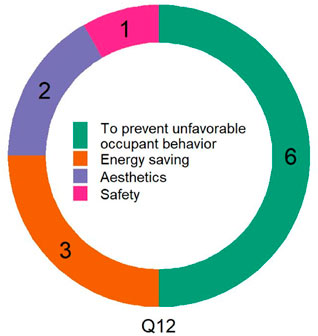- 1Munich University of Applied Sciences, Department 05, CENERGIE—Center for Energy Efficient Buildings and Districts, Munich, Germany
- 2Fraunhofer Institute for Building Physics IBP, Holzkirchen, Germany
- 3Northeastern University, Department of Civil and Environmental Engineering, Boston, MA, United States
Differences in building operator strategies can significantly affect building energy use and occupant comfort. However, it seems that the daily work of building operators and facility managers is still largely based on heuristics and individual experiences. In this work, we have investigated the current data collection methods during the operation and its daily use in buildings as well as the handling of occupant behavior, comfort, and user complaints based on interviews with ten building operators in Germany. These interviews were conducted as part of an international study of building operator OCC (Occupant-Centric Control) strategies, under the auspices of the IEA EBC Annex 79. The results of the interviews clearly reflect, that until now, communication between building operators and building occupants plays a more important role in optimizing or adjusting building operations to meet occupant needs than the data collected by BAS, which is mainly used to detect faults and check the system status of key HVAC components when faults occur. In some cases, the real-time data are applied for the adjustment of set points and schedules depending on measured conditions; however, customization of set points considering the user’s preferred temperature or ventilation rate or building operation based on occupancy detection has not yet been implemented in the considered buildings. The overall objective of this contribution to building operation research is to highlight best practices and identify white spaces that fulfill occupant requirements and achieve a high level of energy-efficiency. The presented findings identify current gaps between science and practice in the field of sustainable optimization of building operation, but also point out real-world starting points for future research and development.
1 Introduction
According to the International Energy Agency (IEA) and the United Nations Environment Programme (UNEP), the buildings and construction sector are responsible for 36% of the global final energy use and subsequently for 39% of the energy-related CO2 emissions in 2018 (IEA and UNEP, 2019). Against the background of the threatening effects of global climate change, increasing the energy-efficiency and thus sustainability in the building sector remains an important and significant ongoing process.
As building codes over the last few decades have improved the energy-efficiency of buildings envelopes, the focus in recent years has shifted to energy-efficient building and equipment operations. This is also reflected in the current political regulations, for example the (revised) “Energy Performance of Buildings Directive” (EPBD) 2010/31/EU (2018/844/EU) (European Parliament and of the Council, 2012; European Parliament and of the Council, 2018) by the European Union. It calls for not only more energy-efficiency in buildings, such as the requirement for all new buildings to be so-called “nearly zero-energy buildings (nZEB)” for public ownership by 2019 and private by 2021, but also requires a “building automation and control system” for non-residential buildings “where technically and economically feasible” to be mandatory by 2025 (European Parliament and of the Council, 2018). This clearly illustrates that these efforts are closely linked to the use of Building Management Systems (BMS), which enable increasingly sophisticated services based on a growing amount of data gathered by technical monitoring (TM).
It is generally acknowledged that, in addition to technical variables, people in buildings play a particularly decisive role in building energy consumption. This is supported by numerous investigations within the framework of the completed International Energy Agency (IEA), Energy in Buildings and Communities Programme (EBC) Annex 66 “Definition and Simulation of Occupant Behavior in Buildings” (Yan et al., 2017), and the ongoing Annex 79 “Occupant-Centric Building Design and Operation” (Wagner and O’Brien, 2018). An observed deviation between the calculated or simulated energy demand from design and the measured energy consumption in operation is often referred to as the term “energy performance gap (EPG).” Individual studies and reviews based on measurements show a wide range in variation between occupants in comparable or identical residential units (Andersen, 2012; Hahn et al., 2020), as well as non-residential buildings (van Dronkelaar et al., 2016; Mahdavi et al., 2021), in their energy consumption up to a factor of 5, and in exceptional extreme cases up to a factor of 20.
As a fundamental precondition, there are two different types of individuals that affect mid- and large-sized commercial buildings in fundamentally different ways: the occupants and the operators. The so-called “occupant” can be defined as the end-user of the services, such as conditioning or ventilation of spaces. The operators and the technical staff in facility management (FM) must be differentiated from this. They are responsible for operation, maintenance, and optimization of the technical equipment. The latter are the people interviewed in this international questionnaire. Nevertheless, all individuals interact with the building and the technical systems and therefore influence energy consumption.
Moving beyond energy-efficient building controls towards occupant-centric controls (OCC) promises to reduce energy consumption more reliably without making occupants uncomfortable. This potential has been shown in simulations and laboratory experiments (Park et al., 2019a; Park et al., 2019b; Park and Nagy, 2020). But it is still questionable whether promised performance can be achieved in real-world applications, especially when applied to the broad building stock. Proposed transformational new technologies, for example in the field of model predictive control (MPC) (Drgoňa et al., 2020), strongly contrasts with the current day-to-day working routine of building operators, especially with regard to the defined tasks and the time already fully allocated for these activities, which is evident in this study. Furthermore, the opportunities to implement new technologies in existing buildings are limited as well.
The aim of this investigation is to collect and assess building operator strategies, the type as well as the use of the data collected in BAS (Building Automation System), and implementation of OCC. Furthermore, it is acknowledged that occupants’ presence and actions (OPA) have a significant impact on achieving an efficient building operation. For this reason, the focus is on the accessibility and usability of occupant-related data for building operators. As a result of this, special attention is paid to the interaction between the occupants of the building and the environment. Since it is assumed that operator heuristics and experiences play a role in this context (Afroz et al., 2020), their practical “know-how” is examined in detail in this study.
The overall objective of this contribution to building operation research is to highlight best practices and identify white spaces that fulfill occupant requirements and achieve a high level of energy-efficiency. The presented findings identify current gaps between science and practice in the field of sustainable optimization of building operation, but also point out real-world starting points for future research and development.
2 Materials and Methods
2.1 Background of Survey
The basis of the following investigations is a questionnaire developed by an expert researcher subgroup within the framework of the IEA EBC Annex 79 “Occupant-Centric Building Design and Operation” (Wagner and O’Brien, 2018). The final structured interview script consists of 23 questions (see Appendix A). The interview started by looking at the interviewees, their official title, relevant training, and experience (i.a. Q1—Q6) as well as their possibilities of operating the buildings’ managed (i.a. Q6). It then addressed the building occupants and comfort (i.a. Q8—Q9), their feedback (i.a. Q14—Q16), and control options (i.a. Q10—Q11). Existing building control systems were recorded and evaluated from the interviewees’ point of view (i.a. Q13, Q17—Q19). Finally, the interviewees’ wishes for expansion on occupant-centered data and/or personal skills, as well as their potential benefit, were investigated (i.a. Q21—Q22).
To meet data privacy requirements, the interviewees remain anonymous, and no personal identification or sensitive data was collected. This human-subjects research initiative initially received research ethics approval at Northeastern University in Boston, MA, United States (IRB # 20–01-01). Additionally, ethics approval was received at each subsequent participating institution including Munich University of Applied Sciences and the Fraunhofer Institute that produced this manuscript. Interviews were carried out in several other countries (e.g., United States, Canada (Afroz et al., 2020; Abuimara et al., 2021), Italy, Poland, Singapore, Switzerland, and Brazil); however, the interviews conducted in Southern Germany are the sole focus of this study. To this end, the survey instrument, originally developed in English, was adapted into local questionnaires—in particular with regard to special features in the individual countries (e.g., educational background).
2.2 Translation of Survey and Responses from/to English
For this purpose, a translation guideline protocol has been developed and applied to ensure equivalence across languages. In order to ensure semantic, conceptual, and normative equivalence of survey questions, the questions were translated into the target language and reviewed by a second person. Furthermore, the resulting translations were tested with a third person to evaluate the comprehension of the questions. Accordingly, this process comprises the following steps:
1) First translation. The English original version (EOV) is translated by the first translator into the target language versions (TV): for this paper, it is German. Translators are instructed to use the same terms that are used in English as far as it is possible.
2) Comparison step. The second translator takes the EOV and the resulting TV from the previous step and independently checks for inconsistencies, mistranslations, meaning, cultural gaps, and lost words or phrases. If any differences are found, the translators are asked to find out why this occurred and how the instrument can be revised.
3) Verification step. The TV is presented to a person not involved in the process of translation and the understanding of the questions is discussed together with one of the translators. If any misunderstandings are found, the translators are asked to find out why this occurred and how the instrument can be revised. A few iterations of this process can occur to ensure proper translation before the final TVs are approved
4) Approval step. If no more misunderstandings or differences are detected, the translation can be approved and released for application.
The translation of the collected responses back into English, the original language of the survey, follows the same principle:
1) Preparation step. Two bilingual translators for each language are identified and introduced into the study. In the best case, these are the same persons who have con-ducted the interviews.
2) First translation. The interview responses in the target language are translated by the first translator into English. Translators are instructed to use the same terms as in the target language as far as is possible.
3) Comparison step. The second translator takes the answers in the target language and the resulting translation into English from the previous step and independently checks for inconsistencies, mistranslations, meaning, cultural gaps, and lost words or phrases. If any differences are found, the translators are asked to find out why this occurred and how the instrument can be revised. A few iterations of this process can occur to ensure proper translation before the final TVs are approved.
4) Approval step. If no more misunderstandings or differences are detected, the translation can be approved and released for submission.
2.3 Conducting the Interviews
The ten German interviews were carried out between 2020–05-27 and 2020–12-01. The interviewees were selected based on the size of the operated building and their experience as well as involvement in this field. Due to the global COVID-19 pandemic, all interviews were carried out by telephone or web-based conference calls and accompanied by two interviewers to be able to precisely ask the questions and transcribe the given answers directly. As a result, the given statements were not documented literally, but were already edited while being transcribed. All interviews were conducted in accordance with the current German data protection regulations (DSGVO (European Parliament and of the Council, 2016)). Thereby, analyses of these data were conducted after anonymization.
2.4 Applied Methods and Limitations
A mixed research approach was applied to examine the transcripts from these 10 interviews. The responses were coded by 18 open-ended questions and five closed-ended questions. The closed-ended questions provided an understanding of the sample demographics compared to the broader population of building operators; however, due to the small sample size qualitative analyses of these responses cannot be considered statistically significant of the sector. Instead, the qualitative analyses focuses on the 18 open-ended questions to understand operator behavior, perceptions, and characteristics in context-specific settings. Quantitative aspects in the mostly closed-ended questions, such as the years of professional experience or the number of managed buildings, are collected as background information. After completing the survey, categories were formed in the analysis from all the responses given, and the answers from single interviews were assigned to them. Thereby all given answers could be completely considered in the analysis.
In this qualitative approach, “reliability and validity are conceptualized as trustworthiness, rigor and quality in qualitative paradigm” (Golafshani, 2015). The aim is to identify important aspects of building operation as well as hurdles and development potentials that point toward a more energy-efficient and sustainable building operation. The results obtained in this study can therefore provide important insights for research and point out areas for development in practice. Nevertheless, the so-called “thematic saturation” (Bryman, 2016) is clearly evident in the interviews due to repetitions: In many thematic areas of the questionnaire, a homogeneous picture of the actual building and system operation as well as and the engagement of the occupants is reflected.
2.5 Research Questions and Themes
The 23 questions in the semi-structured interview script were derived from research questions to understand, among others, the following: How common and effective are various occupant sensors, interferences, and data systems (i.a. Q13, Q17—Q19)? How do operators’ skills, opinions, and trust of occupants affect occupant (dis)comfort and energy use (i.a. Q2—Q5, Q8, Q9)? How do operators learn and apply knowledge of occupants’ needs (i.a. Q14—Q16)? How can building systems be improved to facilitate operators’ ability to meet occupants’ needs (i.a. Q22)? The survey questions may refer to more than one research question, at least as background information, due to adjacent and overlapping topics.
These research questions were revisited when analyzing the interview transcripts, illuminating the following themes to be explored: operators and buildings, operators and occupants, occupants and buildings, building automation systems and sensor technologies, and data analysis. These five themes make up the five sections of the results below.
3 Results
3.1 Operators and Buildings
Figures 1A–D shows the characteristic of the individuals interviewed in this study. Most of them are facility managers and only two participants work as an energy manager. Four interviewees have a technical education such as electrician, installer for heating systems, or plumbing, and six of them have a university degree. Half of them have over 20 years of working experience in the field. Four interviewees are responsible for more than one building. Therefore, for comparability of survey results, interviewees were asked to refer to an exemplary building when answering the questions.
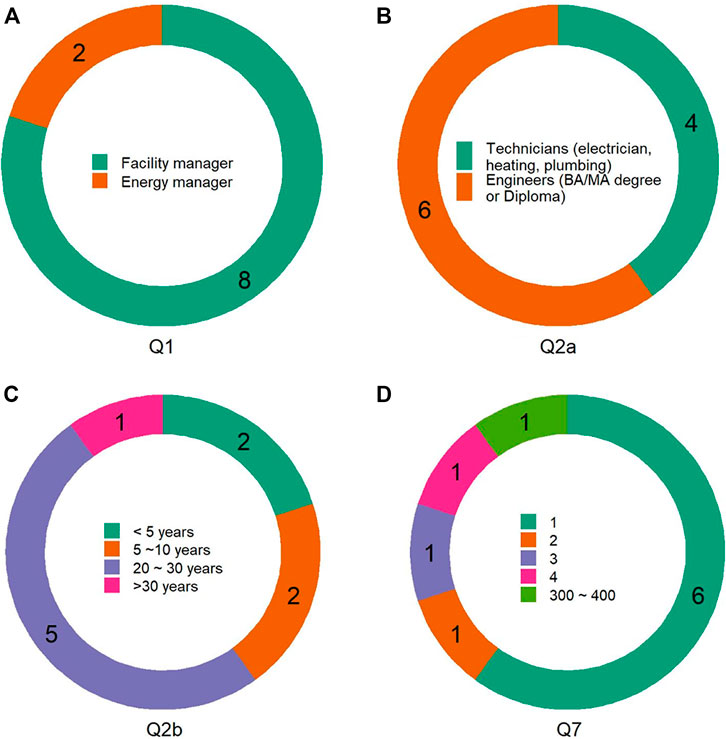
FIGURE 1. (A): Answers to Q1: “What is your job title?” (B): Answers to Q2a: “Please describe your education.” (C): Answers to Q2b: “Please describe your level of experience, which is the most relevant for your employment.” (D): Answers to Q7: “Number of managed buildings.”
According to answers to Q7, interviewees in this study operated buildings in both the private and public (i.e., government) sectors and had predominantly office-like usage. Furthermore, laboratory and lecture buildings as well as commercial and residential use were observed. Net floor areas ranged between 1,000 m2 for single buildings up to the entire aggregation of properties with 90,000 m2 (portfolio managed by one operator/team interviewed. One single interviewed team operates a very large number of buildings (up to 300–400). The number of users in the buildings under consideration varied between 50 and 7,000.
The technical equipment of the considered buildings differs in some points. All buildings have central heating systems (boilers, CHP, heat pumps or district heating) with water-based heat transferal systems installed in the rooms, such as radiators, convectors, floor heating or ceiling panels. Most of the considered buildings have operable windows, which can be opened individually by the occupants. Eight out of the ten buildings also have operable exterior sunshades. Nine buildings have a mechanical ventilation system. Mechanical cooling is not standard in the office areas. The mechanical ventilation and cooling systems are mainly present in mixed-use buildings. In most cases, these systems are intended for large meeting rooms, laboratories, server rooms, or retail spaces, but not for use in office spaces.
3.2 Operators and Occupants
From the possible answers on the question “What are the top two goals that drive your operational decisions?” (Q5) the interviewees could choose from a selection of pre-defined answers. An overview of the selected targets is shown in Figure 2A. In principle, the legal specifications and requirements are just as decisive as the objectives of the building owners. These in turn are bound by the legal requirements and also the desire to save costs, which usually leads to the specification of energy savings. Another important objective is occupant comfort. Most of the respondents stated that they also have a personal interest in operating the buildings as energy-efficiently and occupant-optimized as possible. In this way, they try to anticipate occupants’ complaints and at the same time operate the existing systems as optimally as possible. From the respondents’ answers, it is clear that they do not consider the various objectives for building operations separately, but rather see them in context and act accordingly. For example, the standards and regulations in Germany provide many guidelines for saving energy and maintaining user comfort. In addition, saving energy is often linked to reducing energy consumption costs, while increasing plant efficiency can also contribute to this goal.
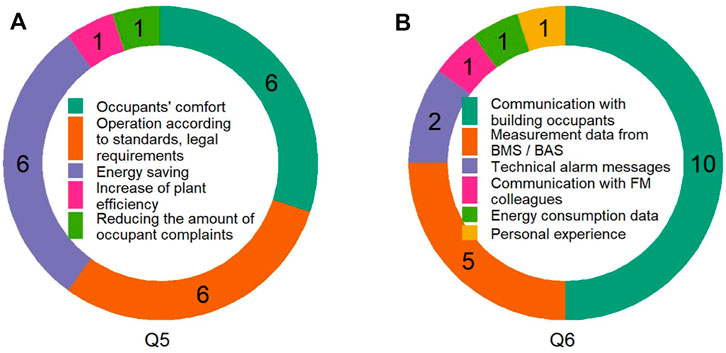
FIGURE 2. (A): Answers to Q5: “What are the top two goals that drive your operational decisions?” (B): Answers to Q6: “What two sources of information help you most in achieving these goals?”
When asked “What two sources of information help you most in achieving these goals?” (Q6), the respondents considered communication with building occupants to be even more important for their work than the data from the building technology, see Figure 2B. The interviewees pointed out that a good exchange with building occupants promotes understanding of their perception of comfort and further enables them to detect and fix occurring defects more quickly. Many everyday faults experienced by building occupants cannot be identified in any other way. Also, sensor and measurement data from Building Automation Systems (BAS) are helpful for technical monitoring of the building systems.
In addition, it seems that the personal occupancy in the managed building clearly influences the personal goals during the building operation. If interviewees spend more than half of their working time in the managed building, they consider the occupants’ comfort more important than the interviewees, who spend no more than 50% of their working time in the building (see Figures 3A,B).
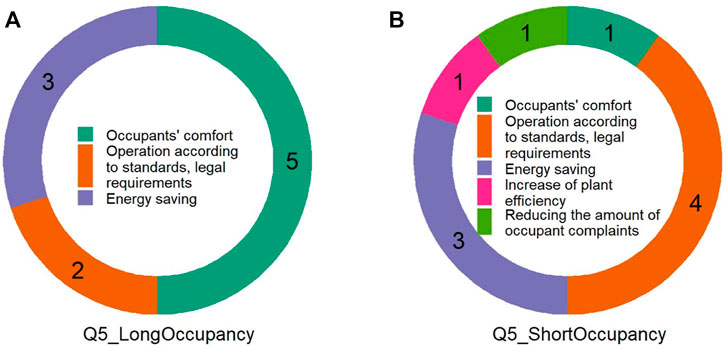
FIGURE 3. Answers to Q5: “What are the top two goals that drive your operational decisions?” (A): Answers from the interviewees who spend more than 50% their working time in the building; (B): Answers from the interviewee who spend no more than 50% of their working time in the building.
Most of interviewees estimate the occupants’ comfort in the managed building to be comfortable or very comfortable and they assume that they understand the occupants’ needs “good” or “even very good” (see Figure 4).
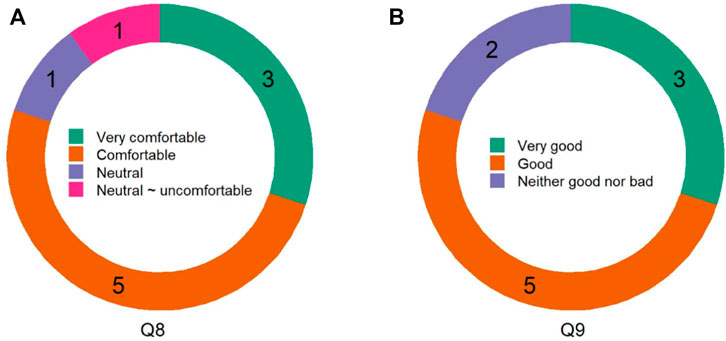
FIGURE 4. (A): Answers to Q8: “How do you estimate the comfort level of the Occupants?” (B): Answers to Q9: “How well do you think are you able to understand the needs of the Occupants?”
3.3 Occupants and Buildings
To get a better understanding of the Human-Building Interactions (HBI), the participants were also asked about the opportunities for occupants to adjust their indoor environment as well as about the measures and reasons for their restriction (Q10, Q11, and Q12).
When asked “please describe typical intervention options for the Occupants in order to make their stay more comfortable,” in almost buildings the set point temperature can be varied (off-set room/zone thermostat) by the occupants by ± 2 to ± 5 K, although the supply temperature in the heating circuit determines the general heating temperature (see Figure 5A). The interviewed building operators stated about the heating system that compromises between the building operation target and the needs of the occupants may be achieved by granting limited occupant influence on the heating units in the offices. In contrast, building occupants rarely have any influence on mechanical ventilation (see Figure 5C), if these exist at all. In the buildings considered in the study, it is mostly possible for occupants to open the windows themselves (see Figure 5B). In the few exceptions where this is not possible or partly not possible, the restrictions were already defined in the construction phase for safety or aesthetic reasons. External Sun shading is mainly manually adjustable, partly supported by a central control system that is linked to weather data and schedules and cannot be intervened by occupants (see Figure 5D).
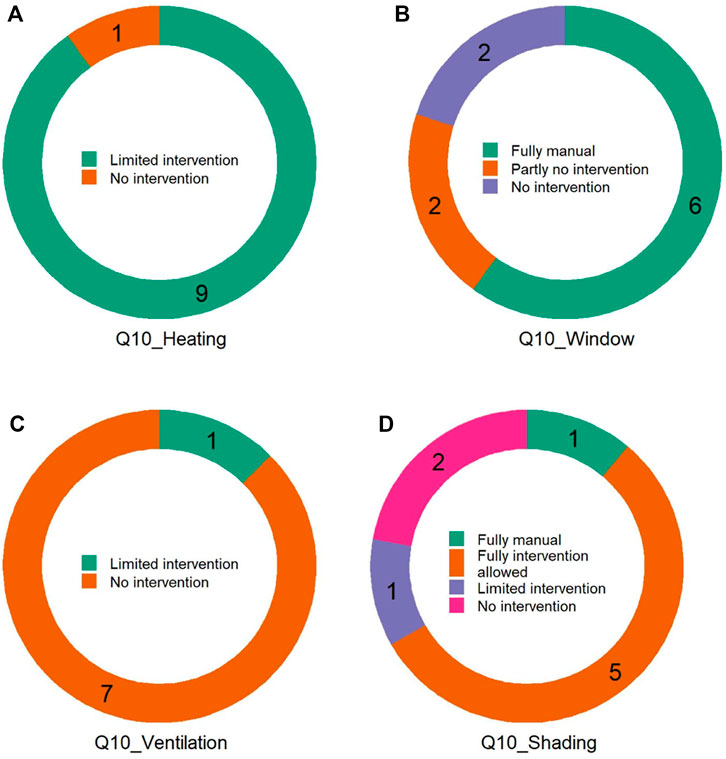
FIGURE 5. Answers to Q10: “Please describe typical intervention options for the Occupants in order to make their stay more comfortable,” (A): Heating, (B): Window, (C): Ventilation, (D): Shading.
The lighting in the considered buildings is not centrally controlled. It can be operated manually in most cases. A lighting-integrated presence detection is partially provided to enable an automatic switch-off in case of absence. Interviewees pointed out that since these systems mainly react to movements, it can happen that the systems switch off the light during deskwork with little movement. This tendency has already led to an accumulation of complaints from occupants among some of the participants; as a result of this question, one respondent remembered that they tried the presence control for the lighting, but there were too many complaints, so they deactivated it again. Other participants report that residents also sometimes do not fully understand the functions and possible interaction options available via the building technology on their own. In order to avoid inappropriate interventions by the occupants as far as is possible, some of the participants try to sensitize the occupants to energy efficiency issues through personal talks or information campaigns (named: print leaflets and posters). Therefore, the main focus is on sensible ventilation behavior by windows and the energy-efficient manual operation of lighting.
The interviewees state that the reason for restricting the occupants’ interventions (Q12) is the prevention of unfavorable occupant behavior, which would result in a high energy consumption and damage energy-saving systems, as shown in Figure 6.
To the Q14 “What is the most common type of complaints, in terms of heating, cooling and air quality of the facility?” the respondents indicated that the complaints they receive from building occupants most often relate to indoor temperature. Across all interviews, the most common complaints the building operators get is that it is too hot in summer and too cold in winter (see Figure 7A). Complaints occur in the morning rather than the afternoon and increase when the weather changes, during transitional periods, and when building occupants have been absent for extended periods of time (see Figure 7B).
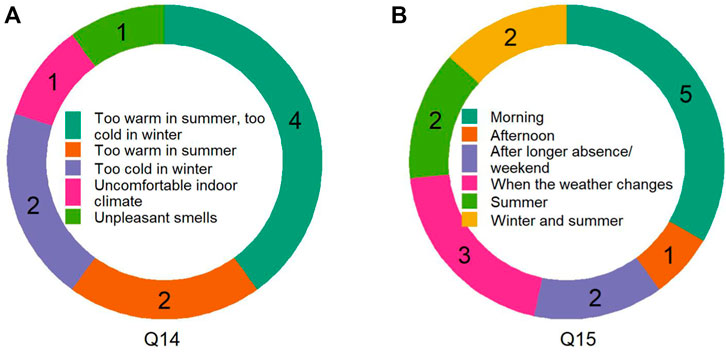
FIGURE 7. (A): Answers to Q14: “What is the most common type of complaints in terms of heating, cooling, and air quality of the facility”? (B): Answers to Q15: “When do the complaints occur the most?”
For example, one participant recalled that there are often individuals who would like to turn on the heaters earlier in the transition between fall and winter than the building operators have planned. The building operators interviewed are well aware of the wide range of comfort requirements, but they always have to find a compromise between the technical possibilities, the operational specifications, and the occupants’ requirements.
3.4 Building Automation Systems and Sensor Technologies
In the survey, the participants were also asked to describe the existing Building Automation System (BAS) in more detail, as well as its most important functions and the available data (Q17). The replies show that all buildings under investigation have management technologies and BAS installed. Nevertheless, the age of the automation systems ranges from here you 2 to 31 years (see Figure 8B) and mainly manages HVAC systems and lighting. Looking at the installed and centrally managed sensors and data, a central recording of presence in the offices or of individual system settings by building occupants is not common in the buildings managed by the interviewees (see Figure 8A). Only in one case is occupancy detection supposed to be available for building operation, but complaints from occupants or lack of maintenance have led to the deactivation of the systems. Therefore, the interviewed building operators rely predominantly on the specifications of set points and schedules, sometimes taking weather data into account. Only one building operator stated that his building is predominantly operated automatically based on current sensor data (e.g., outdoor temperature, brightness, and occupancy). In the other cases, data is also collected but hardly ever integrated into the automation system.
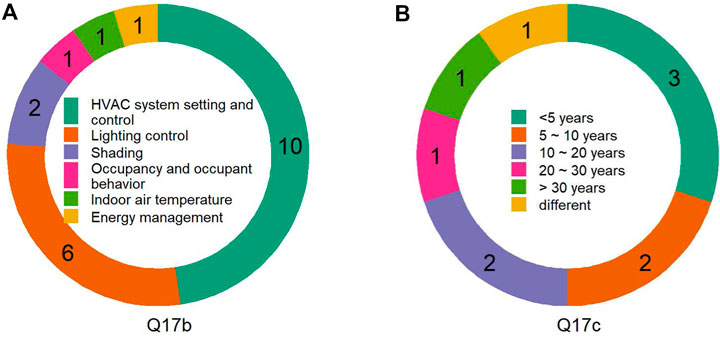
FIGURE 8. (A): Answers to Q17b: “What functions are the most important for you?” (B): Answers to Q17c: “How old is the system?”
The detailed statements of the interviewees show that the existing buildings hardly have any sensors for presence detection and demand-oriented control. In particular, presence sensors can be either “hard-wired” in the electrical installation for user-centric lighting control, or connected to the building automation system. The first case was named in about half of the interviews while the second case seem to be very rare in the buildings under consideration. In addition, some operators mentioned that the absolute number of people in their buildings is recorded via the access control (card). Two respondents described that no technology for demand-based heating, lighting or ventilation such as occupancy sensors, CO2 sensors, etc. is currently installed in their buildings. Generally, thermostatic valves at the radiators are still widely used in the buildings to adjust the preferred room temperature. These thermostatic valves don’t have electronic sensors and are not connected to a central building automation or monitoring system.
3.5 Monitoring and Data Analysis
3.5.1 Current Data Usage
Based on the description of the BAS, the participants were asked about the data that emerges and is used from it (Q17d, Q17e). The interviewees answered that they mainly use the set points and schedules of the heating cycle of HVAC system of BAS as well as technical data of the HVAC system like air pressure or supply water temperature to control the system status of essential equipment components and to eliminate malfunctions indicated by the BAS or complaints by the occupants (see Figure 9A). Additionally, the weather data are also often used (e.g. weather-compensated flow temperature control). A regular evaluation of the archived data is hardly ever carried out. In rare cases, power consumption is evaluated as part of an energy monitoring process. Furthermore, the respondents sometimes receive occupant feedback via an internal ticket system and can then collect and store it in the BAS or separate databases. However, they predominantly receive it separately, for the most part orally, without being archived. Although the indoor air temperature is collected in most cases, it is hardly considered for the building operation (see Figure 9B).
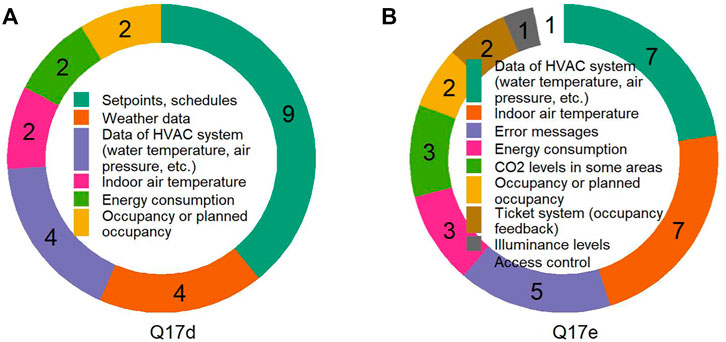
FIGURE 9. (A): Answers to Q17d: “What data is used in the BAS/BMS?” (B): Answers to Q17e: “Data that is collected by the BAS/BMS?”
Due to the lack of other information sources, such as occupant presence, air temperature, and air quality measurements, building operators are mainly dependent on occupant feedback for occupant-oriented optimization of building operation at room level. Since occupant feedback is mostly received only when disturbances and discomfort occur, occupant-oriented building optimization is in most cases focused on preventing complaints. When asked about the potential of the usage of “real-time” or archived information from the BAS to make occupants more comfortable (Q18, the participants expressed a keen interest, see Figure 10). In particular, the optimization of the indoor climate on the basis of the identified preferences and presence of the building occupants was often mentioned. However, this requires more measurement technology, and above all a different building technology that allows the central operation of the room equipment according to individual comfort requirements in the first place. One respondent pointed out that even if he knew exactly which room temperatures the individual occupants preferred, he could not centrally adjust them via the BAS. The reason for this is that the existing heating system only allows the regulation of the central supply temperature.
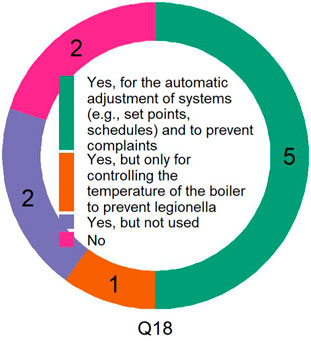
FIGURE 10. Answers to Q18: “Can you use real-time or archived data from the BAS to offer more comfort to the Occupants? Which of the methods do you use?”
The basis and still most common way to control technical systems in buildings (e.g., by set points, ventilation rates – see Q19) are fixed schedules implemented in the BAS as the analyzes of answers clearly demonstrate. Only a single interviewee mentioned demand-controlled systems via automatic adjustment by sensor data (see Figure 11A). Furthermore, most schedules are based on daytime, season and closing days. Additional adaptions are made by occupancy plans for densely occupied rooms such as conference rooms (see Figure 11B).

FIGURE 11. (A): Answers to Q19a: “Are there typical schedules that control the temperature/ventilation rate?” (B): Answers to Q19b: “Are the schedules adapted to occupancy plans, seasons, or specific occasions?”
In addition to inflexible building technology, there are other challenges that building operators face in improving the energy efficiency of the building. Asked about the non-technical challenges in improving energy efficiency in their facility (Q21), the participants stated that data protection guidelines or concerns on the part of building occupants or building owners often prevent extensive access to existing data and their analysis (see Figure 12). In addition, the limited funding for the investment to measurement systems or the required manpower were given as challenges. Some interviewees noted that there is a lack of a sufficient argumentation basis to justify new investments to less interested owners: there is too little data that can be collected and/or analyzed. However, it was positively remarked that a regular exchange between building operators and their clients (building owners or tenants) facilitates building optimization.
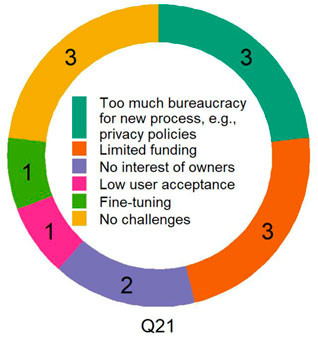
FIGURE 12. Answers to Q21: “Describe the challenges when improving the energy efficiency of the facility”.
3.5.2 Theoretical Opportunities by Further Information
Another question asked about the most important information that the interviewees wish to have access to regarding occupants and occupant comfort and how they would benefit from it (Q22), see Figure 13. In this context, not all building operators actually wish for more (room-related) data, since the existing system technology would not allow more individual operation of the building on a room level as stated above. If more data is desired by the participants, then it is mainly the recording of the presence in the rooms or the number of people in the rooms in order to optimize the system operation, especially the setback phases of the heating system on a building level. Also, some respondents stated interest in additional room-related data and occupant feedback regarding preferred room temperatures and ventilation rates, which they would like to use to make further adjustments to meet occupant comfort requirements as far as the installed technology allows.
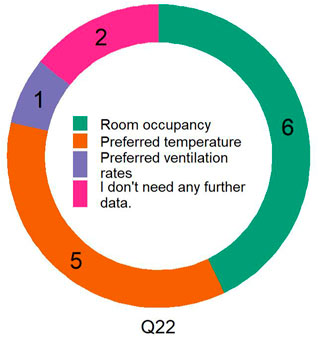
FIGURE 13. Answers to Q22: “What are the most important pieces of information about Occupants and their comfort levels that you would like to have more information about?”
The interviews showed that, currently, communication between building operators and building occupants plays a significant role for optimizing or adjusting building operation to the occupants’ needs. The building occupants are included by the building operators as additional sensors, so to speak. They report abnormal temperatures and peculiar noises, for example, that help operators identify malfunctions and system failures that are not detected by the building automation system. However, relying on occupants as sensors implies that the occupants experience degraded quality of service—the antithesis of many operators’ goals. And similarly, to how faults in system operation are to be avoided, the aim is also to anticipate occupant complaints.
4 Discussion
4.1 Operators and Occupants
Buildings are constructed and operated for people. They should provide a comfortable indoor environment [e.g., DIN EN 15232 (German Institute for Standardization, 2017)] in different domains, such as thermal comfort, indoor air quality (IAQ), acoustic quality, and visual aspects. This becomes evident in green building certification systems such as DGNB (German Sustainable Building Council, 2021) or LEED (LEED, 2021). In addition, there might be further individual needs, for example in terms of safety or privacy. From a technical point of view, however, the general aim is often to operate according to standards or guidelines (e.g., SOPs) with high efficiency and low costs.
The survey revealed that the interviewees are increasingly required to improve the energy efficiency of their building operations by complying with the essential legal requirements (e.g., VDI-MT 3810, Part 1 (German Association of Engineers, 2020). The European targets for CO2 and energy savings (IEA and UNEP, 2019) will also be translated into increasingly restrictive, mandatory requirements for building operation, which will further strengthen this trend in Germany. In addition, building owners are setting further targets such as cost savings or environmental action plans. As these usually go hand in hand with energy savings and energy efficiency optimization, they further reinforce this development. Both the legal and the property specific (e.g., company policies, SOPs) requirements point in the same direction and energy savings usually also result in a reduction in costs and CO2 emissions. According to the survey results, it can be stated that in building operation there is generally a strong focus on improving energy efficiency and thus sustainability. This development is supported by the high self-interest of the interviewees, all of whom are committed to improving the energy efficiency of their buildings beyond the required minimum. In addition, as on-site experts, they are also aware of the occupants’ influence on the operation of the managed buildings and the importance of ensuring occupants’ comfort. The latter is often defined as the self-imposed priority for optimizing the building operation. It can be summarized that the operators’ objectives such as energy efficiency, which is directly linked to costs, are congruent or even beyond the current legal and political requirements.
However, most interviewed operators stated that they do not have sufficient sources of information to fully achieve the defined goals. The survey revealed that the two most important sources of information in achieving these goals is the occupant feedback as well as data generated by the BMS/BAS. Occupant feedback was mentioned twice as often as data from the management systems. Usually, the occupants report malfunctions and uncomfortable indoor climates. Nevertheless, a strong bias must be assumed in the occupants’ information. It must be assumed that mainly very dissatisfied or sensitive individuals provide feedback. Based on this data, it is therefore not possible to draw any conclusions about the occupants as a whole. The interviewees therefore have no choice but to react according to the situation. When permanent adjustments of the building operation are based on the feedback of occupants, they are taken into account in the same way as remote sensors, e.g., to ensure a comfortable room conditioning or to detect malfunctions in the operation of the building systems. The occasionally received occupant feedback, however, does not allow a general analysis of occupant comfort nor a derivation of optimization potentials solely based thereon. However, after improving the system operation, data acquisition, and the building envelope, there is great potential to further optimize the energy efficiency of the building by taking occupant comfort into account (Bordass et al., 2004; Andersen et al., 2013). In order to unlock the potential of an advanced improvement in energy efficiency, increased data collection on the occupant behavior in the building and its analysis would be necessary in most of the buildings considered in this paper.
The measures required to increase energy efficiency primarily depend on the initial situation of the existing building. Findings of the interviews show that in some of the buildings considered, energy efficiency interventions require remedying known deficits, such as improvement of the envelope and systems, before an additional data collection and analysis to leverage further optimization potential. These measures could also provide the building operators with important information to identify and quantify further optimization potential. This would create a basis for argumentation, which would be desired by some of the participants in this study in order to be able to justify the necessary funding for further optimization measures. One of these further measures to increase the energy efficiency of a building could then be the consideration of occupant behavior. Studies already indicate that an adaptation of building operation to occupant comfort and occupant behavior offers an additional field for optimizing the sustainability and energy efficiency of buildings (Bordass et al., 2004; Andersen et al., 2013). In order to tap into this increased possibility of achieving the defined Objectives of Building Operation, a more extensive data collection on the occupant behavior in the building and its analysis is necessary. However, from the survey results, it can be concluded that the current building stock in Germany does not yet offer such opportunities on a broad scale. Only one of the participants stated that he operates a building with the correspondingly required equipment of sensors and coupled building technology. Therefore, there is still an increased need for investment in the area of stock buildings before more advanced approaches could be implemented. These include approaches such as MPC for the automated integration of OCC, which are currently being developed and tested in research (e.g., (Park et al., 2019a; Park and Nagy, 2020)). Also the “human-as-a-sensor” approach is currently examined as a real-time feedback (e.g., (Jayathissa et al., 2020)) to evaluate environmental comfort and improve models regarding adaptive comfort for further design and building operation. It is important to gather the information by a brought loop such as using quick feedback via smart-watches (devices) from a large number of occupants and, therefore, large sampling rates (data streams). In this way, more than discomfort and complaints are recorded and the bias can be reduced.
4.2 Operators and Buildings
In order to achieve maximum energy efficiency in the building sector, it is necessary to be able to realistically consider occupant behavior in the design and operation of buildings (Hong et al., 2015). The survey illustrates that in practice this is mainly done by occupancy schedules. However, the real occupancy of the building is usually much more diverse than what is represented by static schedules. In addition, occupant behavior goes far beyond a simple presence in the building. If possible, occupants operate HVAC systems, sunshades, and lighting; they also open windows and doors. Each of these interactions affects the efficiency of the building’s operation. Following the international research projects IEA EBC Annex 53 (Yoshino et al., 2017) and Annex 66 (Yan et al., 2017), occupant behavior can best be described as observable actions or reactions of a person to external or internal stimuli, respectively, and as actions or reactions of a person as an adaptation to changed environmental conditions, such as temperature, indoor air quality, and sunlight. Moreover, Schweiker et al. (2020) have evaluated the different approaches of multi-domain “indoor environmental perception and behavior.” The considered environmental stimuli, including thermal, visual, acoustic, and air quality related factors, are interconnected to the conditions provided by the operational parameters of the building. Of course, contextual and personal variables have to be taken into account as well. In the publications about modeling occupant behavior, Carlucci et al. (2020) refers to the so-called “OPA: occupant presence and actions” framework considering the different aspects.
The results of the presented survey show that in current BMS/BAS, interaction of humans in buildings is not commonly monitored and analyzed. The influence of these interactions on the operation of buildings is therefore hardly taken into account or not even identifiable due to a lack of implemented technical monitoring systems. Occupants interact with the installed building systems, such as switches for lighting or blinds, windows or thermostats, to adapt their environment according to their needs. A comprehensive review on “human-building interfaces and their relationship to human behavior, energy use and occupant comfort” is provided by Day et al. (2020).
This survey revealed that the personal comfort-oriented interventions of individual occupants to adapt their environment are generally viewed as disruptive factors in building operation. The reason for this perception is predominantly the fact that the effects of occupants’ interventions are rarely in line with the objectives of energy-efficient and optimized building operation. Accordingly, there are several strategies to counter these interventions. The most common is to limit or even completely prevent occupant intervention. This is often already defined in the design phase, but can also be implemented later if necessary, for example if unfavorable occupant interventions occur too frequently. However, several research studies have shown that occupant satisfaction and well-being increases significantly with the possibility of interventions and therefore the perceived control in buildings (Hoes et al., 2009; Sadeghi et al., 2016). Hence, a quick response of the technical systems (or operators) is also important for the occupants to feel comfortable.
In the end, the building operators have to find the right balance between the general operational objectives and individual occupant needs within the range of the possibilities of the individual building design. The strategy of providing limited control options is often used in this context. This means, for example, that the user is granted access to the thermostats or the light, but only to a certain limited extent. In this way, the user’s need for influence can be taken into account without the resulting effect on the operation of the building being too high. An additional issue is that rooms and zones with several occupants often have conflicting requirements in terms of indoor climate, which in practice are technically difficult to fully meet due to the common transfer systems. This can lead to further conflicts.
Based on the adaptive principle of thermal comfort by Humphreys and Nicol (Humphreys and Nicol, 1998), it is usually assumed that people avoid discomfort or circumvent it by adapting themselves or their environment accordingly (Bluyssen, 2009). Therefore, it can be assumed that the interaction between an occupant and the building systems is not random but has a specific goal (Reinhart, 2003). Accordingly, user behavior can be attributed to internal or external stimuli. In the perception, evaluation, and reaction to environmental stimuli, among other things, the subjective perception, the external conditions, and the individual preferences and expectations play a significant role. Consequently, there are other factors influencing user behavior in addition to individual comfort levels. The external conditions can also include targeted information campaigns for occupants on their options for interacting with the building systems, the expected implementation times, e.g., until the room has reached the new set point temperature, and the consequences of the changed operating conditions, such as increased energy consumption due to increased heating requirements.
Three of the interviewees stated that they already have been using the option of occupant information in various ways and have so far had a positive experience with it. The authors of this paper also see the direct communication of building operators with building occupants as a highly useful lever to increase the energy saving potential within the building operation. The authors assume that occupants are often not sufficiently informed about the increasingly complex building systems and their appropriate use; therefore, the authors see adequate occupant training as an important instrument for empowering occupants to make a relevant contribution to energy savings.
4.3 Building Automation Systems and Sensor Technologies
The real challenge in optimizing the building is often the technical standard of building automation. Existing buildings in particular do not currently have the necessary data structure to implement efficient control algorithms.
In traditional building automation systems, data is only collected that is necessary for ensuring fundamental control or essential operating functions (HVAC, etc.). Therefore, in practice, there is frequently neither the sensor technology nor data on detailed information on energy consumption, presence, or user behavior.
The interview results indicate that it is not common practice yet to regularly evaluate the data collected in the BMS. Although the BMS allows trend analyses, the data analysis does not usually exceed the examination of fault messages and the search for their causes. Only one of the considered buildings had more extensive data collection and automated processing. In order to make the collected data suitable for building operators, it is necessary to include advanced visualization and analysis tools. The optimization measures must be designed close to reality, since maintenance, servicing, and ease of use play an important role in long-term and correct use. Therefore, standards and guidelines, implemented in the last years can help to improve the facility management processes.
In July 2017, the guideline VDI 6041 “Technical monitoring of buildings and building services” (German Association of Engineers, 2017) was introduced in Germany to provide the parties involved (planners, operators, facility managers, etc.) with a defined process in facility management. Increased requirements such as the degree of technology and the preferences of the occupants are to be supported with systematically collected data in the subcategories of “energy monitoring (EMon),” “plant monitoring (AMon),” and “building/comfort monitoring (GBMon)” (German Association of Engineers, 2017; Grob et al., 2017).
However, at the initial commissioning of a building as well as in the case of refurbishments or conversions, all technical systems should systematically be put into service together. In Germany, there has been the facility management VDI 6039 “Managing of building commissioning methods and procedures for building-services installations” (German Association of Engineers, 2011) guideline available since 2011. A previously verified monitoring system can support this process with data. The Post-Occupancy Evaluation (POE) process that was implemented in the 1960s (mainly in the US and Canada) has led to buildings being even more closely matched to the needs of the occupants during commissioning (Cooper, 2001; Hadjri and Crozier, 2009). Again, in this case the occupant is used as a “sensor” to gather feedback.
In addition to the systematic collection, storage, and analysis of data, it is also necessary to develop appropriate management measures and KPIs that allow a quick assessment of the building and plant operation, as well as the occupant-related parameters. Hence, O’Brien et al. (2017) and Li et al. (2021) have introduced new occupant-centric measures.
The survey results show that the buildings of the respondents were mostly state of the art at the time of their construction. The focus of renovations of older buildings is predominantly on the upgrading of the facade rather than the building technology and is mostly renewed at the scheduled end of life, or even later if the systems are still running. Maintenance is carried out during operations, but its functions are rarely updated or extended once the system is running.
Special challenges arise when the BMS/BAS is installed in the building but not maintained on a regular basis or not adapted to daily operation. In these cases, the advanced system raises more complaints rather than assisting the building operator in meeting the requirements of energy efficiency and occupant comfort. It is usually only after the building has been commissioned that the actual operation of the building become apparent, which only then reveals the real energy consumption. In order to get a more precise idea of the energy consumers and their influence, a detailed data collection of the building operation is useful. This data can then be utilized to identify and prioritize optimization potentials. It can then be further used to clarify several issues. First, the data can be used to simplify the preparation of the often mandatory annual energy inventories. On the other hand, optimization potentials can be identified and prioritized. Furthermore, adequate data storage can be used to evaluate recurring malfunction reports and to make long-term developments comprehensible.
4.4 Monitoring and Data Analysis
The presented survey shows that there is a high level of interest among all respondents in the integration of new techniques and tools for the exploitation and evaluation of data from the building operation, beyond the conventional measures. However, due to the nature of their job, they do not have a clear concept of how to use or implement these tools, as they are primarily involved in the operation of the building and not in the development of new data management technologies. To optimize building operations, reliable and easily accessible data would be highly useful for building operators. In addition, new approaches from industry and research are needed, as building operators rely mainly on established concepts. Moreover, they can hardly imagine which new technologies might be useful for them. Despite a predominantly strong interest in technical innovations, there is a lack of well-founded training and also working time (mostly already occupied by “distinguishing fires”) to integrate new concepts into regular operations or to transfer concepts from research into practice. In addition, building managers need a sound basis for argumentation to justify investments, especially for the optimization of energy efficiency and comfort. This alone requires knowledge of data analysis and billable processing times, which are not part of a regular building operator job profile.
This is in contrast to the currently targeted state of the art versus state of operation in existing buildings. It can therefore be stated that a holistic improvement of the operation of existing buildings can only be meaningfully approached if, first of all, the necessary sensing technology is installed, including an appropriate extension of the BAS or, if outdated, a replacement of the existing BAS. Building on this, adequate data management tools need to be established and staff needs to be trained. Finally, a sufficient number of operators is significantly important for success in building operations.
5 Conclusion
From the results discussed above, it can be summarized that the interviewees have a high interest in new technologies for optimization of building operations. Most of the respondents also have a high level of education, perhaps not characterizing the broader building operator market in Germany. These two aspects provide a good starting point for the integration of energy efficiency-enhancing approaches for building operations developed in research. However, these approaches are often strongly data-driven. So far, this is in contrast to the day-to-day work of building operators. On the one hand, the buildings under consideration do not yet have the necessary data acquisition or the corresponding building equipment to enable, for example, automated room conditioning according to occupant preferences. On the other hand, most respondents are already facing an investment backlog, which currently often requires the improvement of building envelopes or technical systems. Furthermore, operators are already well engaged with their current tasks, which is why additional optimization concepts will probably require either more personnel or additional time for their implementation as well as application.
Another important aspect mentioned by the participants is the need for a sound basis of argumentation regarding decisive investments to improve energy efficiency. This is particularly required if the building owners do not have a vested interest in this goal. An improved data situation and the necessary knowledge and time for a suitable data analysis could create this basis. Short-term data acquisition with flexible measurement systems could be conceivable for this purpose. However, when collecting data it is necessary to find solutions to meet the relevant regulations and standards while gaining sufficient information.
It can be concluded that in current building operations, fundamentally different challenges are on the agenda than those addressed in research and development. Moreover, there is often a significant gap between existing possibilities (and technologies) in the operation of the building stock and the theoretical approaches used in research. This is mainly due to a different data situation in combination with a different access to system functions in real application versus laboratory or research projects. In order to integrate promising research approaches for increasing energy efficiency and occupant comfort via building operation into practical application, it is therefore necessary to close the gap. This should include simple to handle solutions for data acquisition, management, and knowledge generation adapted to the daily routine in building operations and suitable for use in existing buildings.
Numerous activities in the Annex 79 based on data gathered from the surveys are currently in progress. For example, they deal with the applied tools and the current state of practice. The issues examined concern both national and technological differences.
Data Availability Statement
The datasets presented in this article are not readily available because Due to the sensitive nature of the questions asked in this study, survey respondents were assured raw data would remain confidential and would not be shared.
Ethics Statement
The studies involving human participants were reviewed and approved by Northeastern University IRB # 20–01-01 including the infomed consent process.
Author Contributions
Conceptualization, JH and SH; methodology, JH, SH, MK; interviewers, JH, SH, SP; writing—original draft preparation, JH, SH, MK, SP, WJ; writing—review and editing, JH, SH, MK, SP, WJ; project administration, JH, SH, MK, SP, WJ; All authors have read and agreed to the published version of the manuscript.
Funding
The authors gratefully acknowledge the financial support by the German Ministry of Economic Affairs and Climate Action (BMWi) for the funding of “EnOB: DataFEE - Data mining, machine learning, feedback, and feedforward - Energieeffizienz durch nutzungszentrierte Gebäudesysteme” (grant no.: 03EN1002C) and “EnOB: NuData Campus - Nutzungsdaten basierte Optimierung von Gebäuden und Anlagen am Beispiel der Hochschule München” (grant no.: 03ET1648A). This work was financially supported by the Munich University of Applied Sciences (MUAS) and the German Research Foundation (DFG) through the “Open Access Publishing” program.
Conflict of Interest
The authors declare that the research was conducted in the absence of any commercial or financial relationships that could be construed as a potential conflict of interest.
Publisher’s Note
All claims expressed in this article are solely those of the authors and do not necessarily represent those of their affiliated organizations, or those of the publisher, the editors and the reviewers. Any product that may be evaluated in this article, or claim that may be made by its manufacturer, is not guaranteed or endorsed by the publisher.
Acknowledgments
We thank all participating colleagues for their valuable cooperation and inspiring discussions within the framework of IEA EBC Annex 79. We would also like to thank Bayern Facility Management GmbH for their support in many of the interviews.
Abbreviations
BAS, building automation system; BMS, building management system; DGNB, deutsche gesellschaft für nachhaltiges bauen (german sustainable building council); DIN, deutsches institut für normung (german institute for standardization); EPBD, european performance of buildings directive; CAV, constant air volume; CHP, combined heat and power; EOV, english original version; EPG, energy performance gap; FM, facility management; HBI, human-building interactions; HVAC, heating, ventilation and air conditioning; KPI, key performance indicators; LEED, leadership in energy and environmental design; MPC, model predictive control; OCC, occupant-centric control; OPA, occupants' presence and actions; POE, post-occupancy evaluation; Q, question; SOP, standard operating procedure; TM, technical monitoring; TV, target (language) version; VAV, variable air volume; VDI, verein deutscher ingenieure (association of german engineers).
References
Abuimara, T., Hobson, B. W., Gunay, B., O'Brien, W., and Kane, M. (2021). Current State and Future Challenges in Building Management: Practitioner Interviews and a Literature Review. J. Building Eng. 41, 102803. doi:10.1016/j.jobe.2021.102803
Afroz, Z., Hobson, B. W., Burak Gunay, H., O’Brien, W., and Kane, M. (2020). How Occupants Affect Building Operators’ Decision-Making. ASHRAE J. 62, 22–30.
Andersen, R., Fabi, V., Toftum, J., Corgnati, S. P., and Olesen, B. W. (2013). Window Opening Behaviour Modelled from Measurements in Danish Dwellings. Building Environ. 69, 101–113. doi:10.1016/j.buildenv.2013.07.005
Andersen, R. (2012). The Influence of Occupants’ Behaviour on Energy Consumption Investigated in 290 Identical Dwellings and in 35 Apartments. 10th Int. Conf. Heal. Build. 3, 2279–2280.
Bordass, B., Associates, W. B., and Cohen, R. (2004). Energy Performance of Non-Domestic Buildings: Closing the Credibility Gap. 8th Int. Conf. Improv. Energ. Effic. Commer. Build. 1–10.
Carlucci, S., De Simone, M., Firth, S. K., Kjærgaard, M. B., Markovic, R., Rahaman, M. S., et al. (2020). Modeling Occupant Behavior in Buildings. Building Environ. 174, 106768. doi:10.1016/j.buildenv.2020.106768
Cooper, I. (2001). Post-Occupancy Evaluation - Where Are You? Build. Res. Inf. 29, 158–163. doi:10.1080/09613210010016820
Day, J. K., McIlvennie, C., Brackley, C., Tarantini, M., Piselli, C., Hahn, J., et al. (2020). A Review of Select Human-Building Interfaces and Their Relationship to Human Behavior, Energy Use and Occupant Comfort. Building Environ. 178, 106920. doi:10.1016/j.buildenv.2020.106920
European Parliament and of the Council (2018). Directive 2010/31/EU on the Energy Performance of Buildings and Directive 2012/27/EU on Energy Efficiency. Off. J. Eur. Union 156/75, 1–17. European Parliament and of the Council DIRECTIVE (EU) 2018/844 of the European Parliament and Council (Revised EPBD) of 30 May 2018 Amending.
Drgoňa, J., Arroyo, J., Cupeiro Figueroa, I., Blum, D., Arendt, K., Kim, D., et al. (2020). All You Need to Know about Model Predictive Control for Buildings. Annu. Rev. Control. 50, 190–232. doi:10.1016/j.arcontrol.2020.09.001
European Parliament and of the Council (2012). Commission Delegated Regulation (EU) No 244/2012 of 16 January 2012 Supplementing Directive 2010/31/EU of the European Parliament and of the Council on the Energy Performance of Buildings by Establishing a Comparative Methodology Framework for Calculating. Off. J. Eur. Union 28. doi:10.3000/1977091X.C_2012.115.eng
European Parliament and of the Council (2016). Directive 95/46/EC of the European Parliament and of the Council of 24 October 1995 on the Protection of Individuals with Regard to the Processing of Personal Data and on the Free Movement of Such Data.
German Association of Engineers (2011). VDI 6039: Facility Management - Managing of Building Commissioning Methods and Procedures for Building-Services Installations.
German Association of Engineers (2017). VDI 6041: Facility Management - Technical Monitoring of Buildings and Building Services.
German Association of Engineers (2020). VDI-MT 3810, Part 1 Draft: Operation and Maintenance of Building Installations – Fundamentals (Betreiben Und Instandhalten von Gebäuden Und Gebäudetechnischen Anlagen - Grundlagen).
German Institute for Standardization (2017). DIN EN 15232 Energy Performance of Buildings – Part 1: Impact of Building Automation, Controls and Building Management (Energieeffizienz von Gebäuden - Teil 1: Einfluss von Gebäudeautomation Und Gebäudemanagement).
German Sustainable Building Council (DGNB) (2021). Overview of the Criteria. Online. Available at: https://www.dgnb-system.de/en/buildings/in-use/criteria/(Accessed on March 30, 2021).
Golafshani, N. (2015). Understanding Reliability and Validity in Qualitative Research. Tqr 8, 597–606. doi:10.46743/2160-3715/2003.1870
Grob, R. F., Hahn, J., and Tritschler, M. (2017). “Kapitel 5 B: Technisches Monitoring und Betriebsoptimierung,” in Praxishandbuch Green Building. Editors P. Mösle, M. Lambertz, S. Altenschmidt, and C. Ingenhoven (Berlin, Boston: De Gruyter), 436–443. 9783110275285.
Hadjri, K., and Crozier, C. (2009). Post-occupancy Evaluation: Purpose, Benefits and Barriers. Facilities 27, 21–33. doi:10.1108/02632770910923063
Hahn, J., Schumacher, P., Lang, W., and Jensch, W. (2020). “Performance Gap and Occupant Behavior – Review and Analysis of High-Efficiency Residential Buildings in Germany,” in Proceedings of the ECOS 2020 - Proceedings of the 33rd International Conference on Efficiency, Cost, Optimization, Simulation and Environmental Impact of Energy SystemsECOS 2020 Local Organizing Committee 1-1 Gakuen-cho, Naka-ku, Sakai, Osaka 599-8531, Japan: Osaka, Japan. Editors R. Yokoyama, and Y. Amano, 2023–2035.
Hoes, P., Hensen, J. L. M., Loomans, M. G. L. C., de Vries, B., and Bourgeois, D. (2009). User Behavior in Whole Building Simulation. Energy and Buildings 41, 295–302. doi:10.1016/j.enbuild.2008.09.008
Hong, T., D'Oca, S., Turner, W. J. N., and Taylor-Lange, S. C. (2015). An Ontology to Represent Energy-Related Occupant Behavior in Buildings. Part I: Introduction to the DNAs Framework. Building Environ. 92, 764–777. doi:10.1016/j.buildenv.2015.02.019
Humphreys, M. A., and Nicol, J. F. (1998). “Understanding the Adaptive Approach to Thermal Comfort,” in Proceedings of the ASHRAE Transactions.
IEA and UNEP (2019). Global Status Report for Buildings and Construction: Towards a Zero-Emissions, Efficient and Resilient Buildings and Construction Sector; 2019. Vol. 224; ISBN 9789280737684.
Jayathissa, P., Quintana, M., Abdelrahman, M., and Miller, C. (2020). Humans-as-a-Sensor for Buildings-Intensive Longitudinal Indoor Comfort Models. Buildings 10, 174–222. doi:10.3390/buildings10100174
LEED (2021). Certification for Existing Buildings and Spaces: LEED for Operations and Maintenance. Online. Available at: https://www.usgbc.org/leed/rating-systems/existing-buildings (Accessed on March 31, 2021).
Li, H., Wang, Z., and Hong, T. (2021). Occupant-Centric Key Performance Indicators to Inform Building Design and Operations. J. Build. Perform. Simul. 14, 814–842. doi:10.1080/19401493.2021.1876771
Mahdavi, A., Berger, C., Amin, H., Ampatzi, E., Andersen, R. K., Azar, E., et al. (2021). The Role of Occupants in Buildings' Energy Performance Gap: Myth or Reality? Sustainability 13, 3146. doi:10.3390/su13063146
O’Brien, W., Gaetani, I., Carlucci, S., Hoes, P.-J., and Hensen, J. L. M. (2017). On Occupant-Centric Building Performance Metrics. Build. Environ. 122, 373–385. doi:10.1016/j.buildenv.2017.06.028
Park, J. Y., Dougherty, T., Fritz, H., and Nagy, Z. (2019). LightLearn: An Adaptive and Occupant Centered Controller for Lighting Based on Reinforcement Learning. Building Environ. 147, 397–414. doi:10.1016/j.buildenv.2018.10.028
Park, J. Y., and Nagy, Z. (2020). “HVACLearn,” in e-Energy 2020 - Proc. 11th ACM Int. Conf. Futur. Energy Syst, 434–437. doi:10.1145/3396851.3402364
Park, J. Y., Ouf, M. M., Gunay, B., Peng, Y., O'Brien, W., Kjærgaard, M. B., et al. (2019). A Critical Review of Field Implementations of Occupant-Centric Building Controls. Building Environ. 165, 106351. doi:10.1016/j.buildenv.2019.106351
Reinhart, C., (2003). Monitoring Manual Control of Electric Lighting and Blinds Reinhart, C.F.; Voss, K. NRCC-45701. Light. Res. Technol. 35, 243–260. doi:10.1191/1365782803li064oa
Sadeghi, S. A., Karava, P., Konstantzos, I., and Tzempelikos, A. (2016). Occupant Interactions with Shading and Lighting Systems Using Different Control Interfaces: A Pilot Field Study. Building Environ. 97, 177–195. doi:10.1016/j.buildenv.2015.12.008
Schweiker, M., Ampatzi, E., Andargie, M. S., Andersen, R. K., Azar, E., Barthelmes, V. M., et al. (2020). Review of Multi‐Domain Approaches to Indoor Environmental Perception and Behaviour. Building Environ. 176, 106804. doi:10.1016/j.buildenv.2020.106804
van Dronkelaar, C., Dowson, M., Spataru, C., and Mumovic, D. (2016). A Review of the Regulatory Energy Performance Gap and its Underlying Causes in Non-Domestic Buildings. Front. Mech. Eng. 1, 1–14. doi:10.3389/fmech.2015.00017
Wagner, A., and O’Brien, L. (2018). IEA EBC Annex 79: Proposal - Occupant Behaviour-Centric Building Design and Operation. Int. Energy Agency.
Yan, D., Hong, T., Dong, B., Mahdavi, A., D’Oca, S., Gaetani, I., et al. (2017). Final Report of IEA EBC Annex 66: Definition and Simulation of Occupant Behavior in Buildings, 156. doi:10.1016/j.enbuild.2017.09.084
Yoshino, H., Hong, T., and Nord, N. (2017). IEA EBC Annex 53: Total Energy Use in Buildings-Analysis and Evaluation Methods. Energy and Buildings 152, 124–136. doi:10.1016/j.enbuild.2017.07.038
Appendix A: Original Questions from the International Survey (IEA EBC Annex 79)
1) What is your title and employment relationship?
2) Please describe your experience/credentials that you find most relevant to this job.
3) How often are you personally occupying (each/the) building(s) you manage?
4) Do your own personal demands for comfort effect how you manage the building?
5) What are the top two goals that drive your operational decisions? Are these your personal goals or goals established by the company?
6) What two sources of information help you most in achieving these goals?
7) Describe the building(s) you manage in terms of number of buildings, use, size, and number of occupants:HVAC system type: CAV, VAV, hydronic; Public vs privately owned; Owned or rented by primary occupant.
8) How comfortable do the building occupants seem to be?
9) How well do you feel that you understand the needs of building occupants?
10) Describe the most typical ways users make their space a more comfortable and your responses?
11) In what ways do you restrict how users can adjust the indoor temperature?
12) What are the reasons for limiting occupants’ influence?
Can you think of an example from your practice?
13) Does your building have occupancy sensors or CO2 sensors?
If so, how many are there and how are they used?
14) What is the most frequent complaint type you receive regarding the heating, cooling, and air quality of the facility?
15) When do these complaints typically occur?
16) How often do you communicate (e.g., in-person or surveys) with building occupants about your job?
17) Please describe the building automation system (BAS), if applicable. How old is it?
What features are most important to you?
Does it manage lighting and/or plug loads?
Which of these data are archived?
If there is not a BAS, skip Q18.
18) How could you use “real-time” or archived information from the BAS to make occupants more comfortable?
Which of these methods do you utilize?
19) Describe any typical start and stop schedules of temperature set points and ventilation rates?Are these schedules changed for occupant schedules, seasons, or special events?
20) How would you rate the energy efficiency of the building?
21) Describe non-technical (e.g., inter-personal, organizational) challenges in improving energy efficiency in your facility?
22) What is the most important information that you wish you had access to regarding occupants and occupant comfort?a) How would you benefit from having access to this information?b) Are there skills, tools, or knowledge you wish you had access to better understand and provide occupant comfort?
23) Is there anything else you would like to tell us about how you manage occupant comfort and its relationship with automation systems?
Keywords: occupant comfort, occupant behavior, operator, interviews, operation & maintenance, building operation, occupant-centric building operation, energy effciency
Citation: Hahn J, Heiler S, Kane MB, Park S and Jensch W (2022) The Information Gap in Occupant-Centric Building Operations: Lessons Learned from Interviews with Building Operators in Germany. Front. Built Environ. 8:838859. doi: 10.3389/fbuil.2022.838859
Received: 18 December 2021; Accepted: 11 March 2022;
Published: 02 May 2022.
Edited by:
Sergio Sibilio, University of Campania Luigi Vanvitelli, ItalyReviewed by:
Mohamed Ouf, Concordia University, CanadaGraziano Salvalai, Politecnico di Milano, Italy
Michelangelo Scorpio, University of Campania Luigi Vanvitelli, Italy
Copyright © 2022 Hahn, Heiler, Kane, Park and Jensch. This is an open-access article distributed under the terms of the Creative Commons Attribution License (CC BY). The use, distribution or reproduction in other forums is permitted, provided the original author(s) and the copyright owner(s) are credited and that the original publication in this journal is cited, in accordance with accepted academic practice. No use, distribution or reproduction is permitted which does not comply with these terms.
*Correspondence: Jakob Hahn, amFrb2IuaGFobkBobS5lZHU=
 Jakob Hahn
Jakob Hahn Sarah Heiler2
Sarah Heiler2 Michael B. Kane
Michael B. Kane Sumee Park
Sumee Park